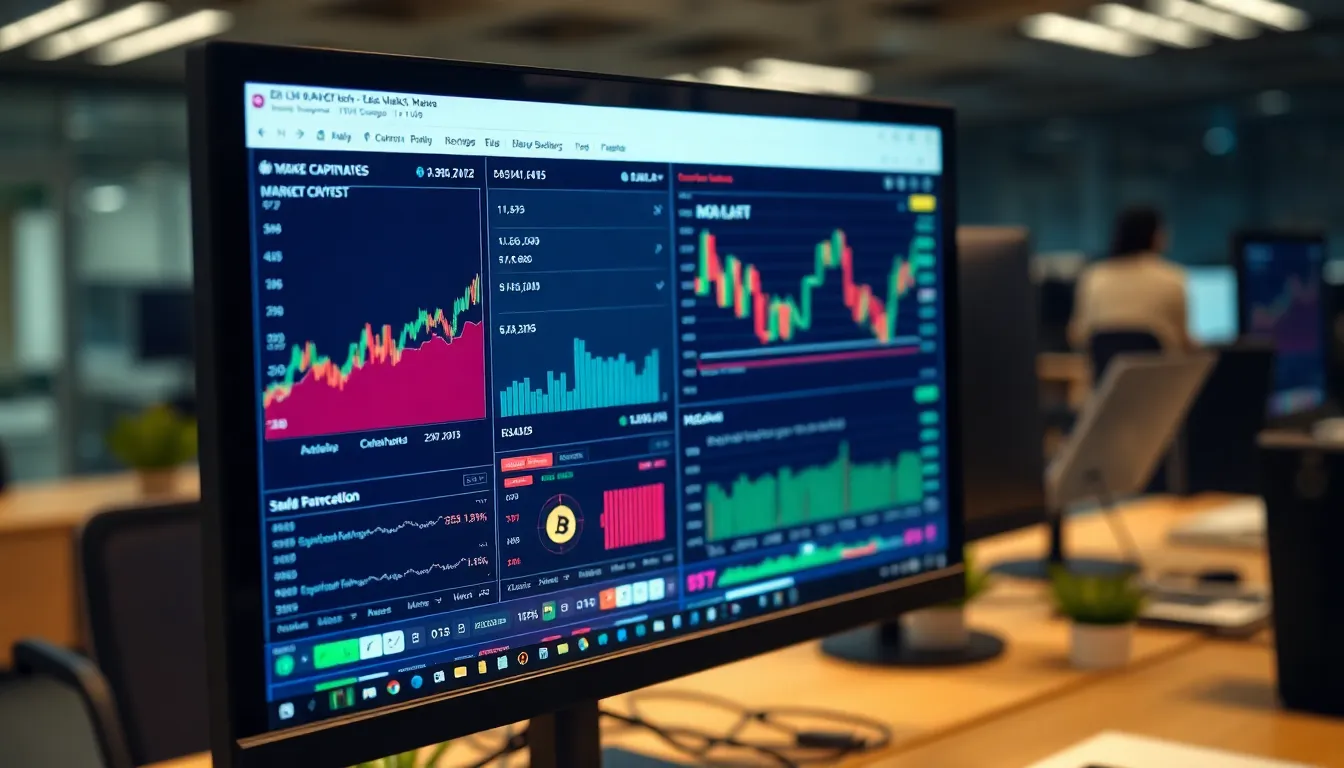Table of Contents
ToggleIn the wild world of cryptocurrency, where fortunes can flip faster than a pancake on a Sunday morning, understanding the market is crucial. Whether you’re a seasoned trader or just dipping your toes into the digital waters, navigating this volatile landscape can feel like trying to tame a bull in a china shop. But don’t worry; it’s not all doom and gloom.
Armed with the right analysis, anyone can ride the waves of crypto like a pro surfer. From Bitcoin’s wild price swings to the latest altcoin trends, a solid grasp of market analysis can turn confusion into clarity. Buckle up as we dive into the essentials of crypto market analysis, where data meets strategy and a sprinkle of humor makes the ride a little smoother.
Overview of Crypto Market Analysis
Crypto market analysis involves studying trends and patterns to evaluate price movements. Traders utilize various tools to gain insights and make informed decisions, especially amidst the market’s volatility. Identifying key indicators plays a significant role in this process.
Market sentiment often drives price fluctuations. When positive news surfaces, crypto assets like Bitcoin can experience rapid increases in value. Conversely, negative developments can lead to sharp declines, impacting multiple altcoins.
Technical analysis remains a crucial aspect of market evaluation. By examining historical price charts, traders uncover potential support and resistance levels. Chart patterns provide visual cues, highlighting trends such as bullish or bearish movements.
Fundamental analysis complements the technical approach. It focuses on assessing the underlying factors influencing cryptocurrencies. A coin’s utility, development team, and market demand contribute to its value. For instance, major partnerships or innovative projects can elevate investor interest.
Staying updated with news and events enhances market analysis effectiveness. Knowledge of regulatory changes, technological advancements, or macroeconomic factors can shape market behavior. Engaging with reliable news sources ensures traders remain informed about potential impacts on their investments.
Quantitative analysis introduces numerical data into the mix. Metrics like trading volume and market capitalization offer additional perspectives. These figures can indicate the overall health and liquidity of a cryptocurrency, influencing trading strategies.
Overall, mastering crypto market analysis equips traders with essential skills. It helps navigate the complexities of the cryptocurrency landscape while making well-informed decisions based on data-driven insights. Understanding the significance of both technical and fundamental analysis fosters a more strategic approach to trading.
Key Metrics for Analysis

Understanding key metrics is essential for effective crypto market analysis. Two critical metrics include market capitalization and trading volume.
Market Capitalization
Market capitalization reflects the total value of a cryptocurrency within the market. Calculated by multiplying the current price of a coin by its circulating supply, this metric helps assess a coin’s relative size. A high market cap indicates stability while a low market cap may suggest volatility. For instance, Bitcoin’s market cap typically eclipses hundreds of billions, showcasing its market dominance. Investors often reference market cap to compare different cryptocurrencies and gauge potential returns. Tracking changes in market capitalization over time can also signal trends in investor sentiment. Overall, it serves as a foundational metric in any comprehensive market analysis.
Trading Volume
Trading volume represents the total amount of cryptocurrency traded within a specific time frame, typically measured in 24 hours. Higher trading volumes often indicate increased investor interest and liquidity, making it easier to buy or sell assets without significant price movement. For example, a surge in trading volume for an altcoin might precede a price rally, attracting more traders. Conversely, low trading volume can signal a lack of interest, potentially leading to price stagnation. Analysts routinely monitor trading volume in conjunction with price changes to identify trends or potential reversals. This metric becomes vital when assessing market conditions.
Technical Analysis in Crypto
Technical analysis plays a crucial role in understanding the cryptocurrency market. This method relies on historical price data to forecast future movements.
Chart Patterns
Chart patterns serve as visual tools that highlight trends in price behavior. Common formations include head and shoulders, triangles, and flags. Traders often interpret these patterns to predict price reversals or continuations. For instance, a head and shoulders formation typically signals a downward trend, while a bullish triangle may indicate a forthcoming price increase. Recognizing these patterns helps traders identify potential trading opportunities and manage risk effectively.
Indicators and Tools
Indicators and tools enhance the decision-making process in technical analysis. Popular indicators include moving averages, Relative Strength Index (RSI), and Bollinger Bands. Moving averages smooth out price data to show trends more clearly. RSI gauges market momentum, indicating overbought or oversold conditions. Bollinger Bands provide insights into volatility, showing how price fluctuates around a moving average. By leveraging these tools, traders can make data-driven decisions and adjust their strategies based on market conditions.
Fundamental Analysis in Crypto
Fundamental analysis plays a vital role in evaluating cryptocurrencies. Assessing various factors provides insights into a project’s potential success.
Project Evaluation
Evaluating a crypto project involves examining its whitepaper, technological features, and team qualifications. A strong whitepaper outlines the project’s vision and technology, showcasing its potential impact within the industry. Team qualifications also contribute significantly, as experienced professionals can drive successful implementations. Community engagement serves as another critical aspect; active communities indicate robust support and interest. Additionally, partnerships and collaborations enhance credibility, indicating trust within the market. Analyzing the project’s utility and real-world applications provides a clear picture of its sustainability and growth prospects.
Market Trends
Identifying market trends offers crucial insights into price movements. Recognizing overall market sentiment helps traders make informed decisions. Historical data demonstrates recurring cycles, making trend analysis essential. Seasonal effects can influence crypto trading patterns, with certain months often experiencing increased activity. Influential news and events impact trends; for example, regulatory announcements tend to create significant market reactions. Awareness of trading volumes supports trend identification, as higher volumes often confirm bullish or bearish movements. Understanding these factors allows traders to anticipate potential shifts in the market landscape.
Risks and Challenges in Crypto Market
Volatility poses a significant risk in the crypto market. Traders often face unpredictable price swings that can result in substantial financial losses. Awareness of these fluctuations is crucial for making sound investment choices.
Regulatory uncertainty also presents challenges. Various governments worldwide impose different regulations, leading to confusion among investors. Compliance with regulations can affect market access and operational legitimacy for cryptocurrencies.
Security concerns cannot be overlooked. Cybersecurity threats, such as hacking and fraud, jeopardize user funds and data. Implementing strong security measures is essential for protecting assets in the crypto space.
Market manipulation contributes to instability. Practices like pump and dump schemes can mislead investors, resulting in financial loss. Transparency in trading practices provides a more reliable market environment.
Liquidity issues affect cryptocurrency trading. Low liquidity can hinder a trader’s ability to execute orders promptly and at desired prices. Recognizing the liquidity levels of different assets helps traders make informed decisions.
Technology risks also play a role in the crypto market. Software bugs and network outages can lead to transaction failures and loss of funds. Monitoring technical developments and updates is vital for safeguarding investments.
Psychological factors impact decision-making. Emotional trading often leads to rash decisions based on fear or greed rather than analysis. Cultivating a disciplined trading strategy helps mitigate emotional influences.
Market inertia can create barriers. Slow adoption rates of specific cryptocurrencies might impede growth and development. Understanding market dynamics enables traders to identify potential shifts and opportunities.
Overall, recognizing these risks enhances traders’ ability to navigate complexities in the crypto market.
Mastering crypto market analysis is essential for anyone looking to thrive in this dynamic environment. With the right tools and insights traders can better navigate the complexities of price movements and market sentiment. Understanding key metrics like market capitalization and trading volume empowers individuals to make informed decisions.
Awareness of fundamental and technical analysis further enhances one’s ability to evaluate potential investments. Staying updated on news and trends is equally important as the crypto landscape is ever-evolving. By combining analytical skills with a keen awareness of risks, traders can position themselves for success in the cryptocurrency market.




